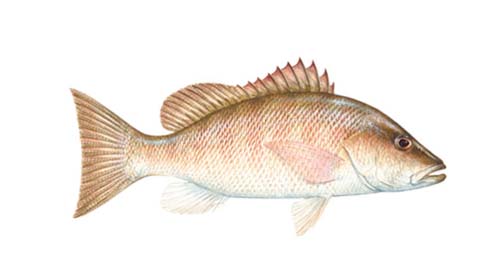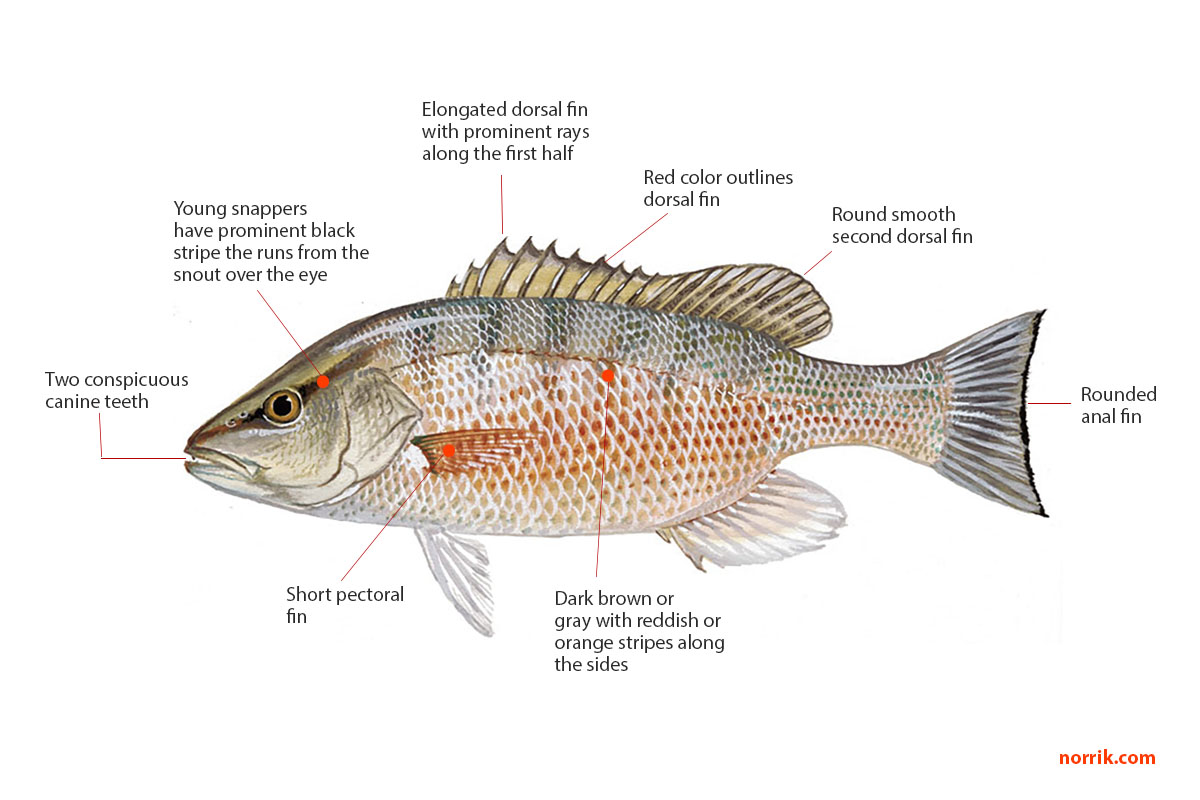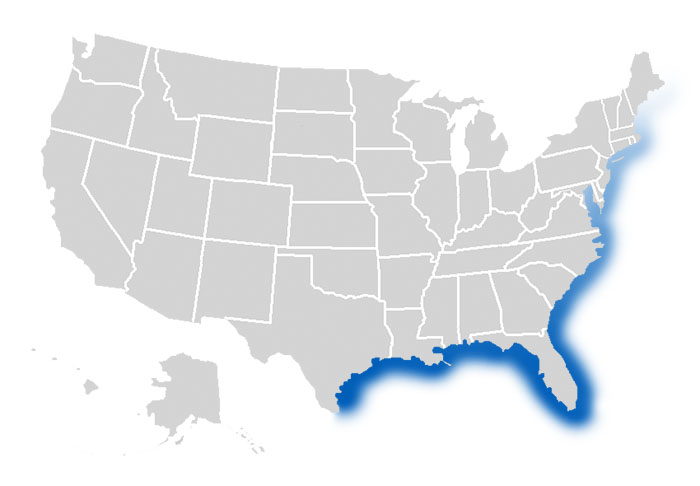Peak fishing season for Mangrove snappers is July and August. The best methods for catching Mangrove snappers are bottom bouncing, drift fishing and jigging just offshore around reefs and shipwrecks using a #3-#1 J hook or 1/0 – 3/0 circle hook baited with small piece of shrimp.

Habitat: Bay, Ocean
How to identify Mangrove Snapper
Mangrove snappers are typically bright red to copper red in coloring. Adult mangrove snapper have rows of reddish orange dots that extend along their sides. They are distinguished by their large mouths, pointy snouts, slim bodies and a dark strip that runs across their eye. They have paired fins which are lighter in color than their median fins, along with a rounded anal fish and short pectoral fins that doesn’t quite reach the anal fin. It’s impossible to distinguish between a male and female mangrove snapper just by looking at them.

Young mangrove snappers are generally gray-green with tinges of red and small red-orange markings on their sides. Their paired fins are lighter than the median fins, which have a yellow/white edging. Younger mangroves have dark striping that runs from their snout past the eyes. Just below the eyes in the cheek area is a subtle, blue stripe.
The mangrove snapper is one of the smaller species of snapper. Adult mangrove snappers rarely exceed 18 inches in length and 10 pounds, but larger specimens have been recorded. The largest mangrove snapper on recorded weighed in at over 44 pounds.
Where to catch Mangrove Snapper
Mangrove snappers are found throughout the southeast coastal U.S., the Gulf of Mexico, the Caribbean, and Brazil up through the Bahamas and Bermuda. They prefer warmer regions and are heavily concentrated throughout the Florida keys and along Florida’s western coast.

These fish can be found in and around bays, marinas, mangroves, docks, grass flats, canals, reefs, shipwreks, inshore structures and open water. In open water, Mangrove snapper tend to congregate near bottom structure, shipwrecks and reefs. They can be found at a depth of about 20 to 600 feet, although most are found at depths less than 200 feet.
The following are habitats where you can catch Mangrove Snapper:
- Estuaries
- Channel Entrances
- Coastal Waters
- Jetties and Breakers
- Man-made Structures
- Mangroves
- Reefs, Wrecks and Shoals
- Rocky Sea Floor
- Saltwater Weed Beds
How to catch Mangrove Snapper
Peak fishing season for the mangrove snapper is from June through August. They tend to congregate in large numbers around the reef line during July and August, and are especially active during a full moon. Night fishing for Mangrove snapper during this time can be effective. Anglers can use the same tactics to catch mangrove snappers that they use for catching yellowtails, including chumming.
How you fish for mangrove snapper will depend in large part on where the fish is located in the water column. An all around effective setup for catching mangrove snapper is a split shot rig with a #3-#1 jhook or 1/0-3/0 circle hook baited with a live shrimp, crab or white bait. This rig is ideal for fishing around docks, pilings and other near-shore structure. Your hook size will depend on the size of fish you’re targeting.
While mangrove snapper can be found throughout the water column, they tend to be a bottom dwelling species. Fishing mid depth down to the bottom will improve your catch rate. When fishing tight to the bottom the sliding sinker rig (slip sinker) fitted with a circle hook and baited is an effective setup. Another effective presentation for bottom fishing is the knocker rig. Always, use the smallest weight possible to hold your line to the bottom.
Use as light as line as possible when fishing mangrove snapper, especially in shallow clear water. In deeper waters we recommend 40lb test as a bare minimum. For shallower waters, a 15-30lb test line should work. When fishing near heavy cover, using a braided line is best. Mangrove snapper are notorious for heading for structure as soon as they feel the hook in their mouth. You want to have a strong line and abrasion resistent fluorocarbon leader that won’t snap.
Common techniques for catching mangrove snappers include bottom bouncing, drift fishing, jigging and spin casting. Mangrove snapper can also be caught using the following fishing methods.
The following are effective fishing methods and techniques for catching Mangrove Snapper:
Best Lures, Bait & Tackle to catch Mangrove Snapper
Mangrove snappers can be caught using live bait, cut bait or lures. The best bait for catching mangrove snapper is live shrimp or Mud Minnos, though dead fish and crustaceans work well too. Other bait options include small pinfish, sardines, finger mullet, and crabs.
For anglers who want to use artificial lures, a white or natural scented soft plastic immitation shrimp on a 1/16 or 1/8 ounce red jig head is effective for catching mangrove snapper. Using a small gold or silver spoons is another good lure option.
When using artificial lures to fish mangrove snapper, it’s important to select a lure that is small enough to fit in their small mouth.
The following are fishing lures, bait and tackle that can be used to catch Mangrove Snapper:
In shallow inshore waters mangrove snappers typically don’t exceed 2-3 pounds at most. Any light tackle will work for catching mangrove snapper inshore. The most common setup for targeting Mangrove snappers is a light action rod and spinning reel combo. For fishing structure, baitcasting reels also work well.
Techniques for Bait Fishing
Mangrove snapper can’t resist live bait, especially live shrimp. But the right presentation will greatly improve your catch rate. One of the best methods for presenting bait near structure is to cast your bait just up current from the structure. Mangrove snapper are ambush predators. When the bait passes near the structure the snapper will dart out to take the bait.
Targeting structure also works when fishing from from docks, bridges or piers. Find the water where there’s structure and current, and you’ll find the snappers. Look for rock piles, holes or any structure big enough to hide a snapper. Again, place the bait just up current from the structure and allow it to make its way down past the structure.
Mangrove snappers are typically strong feeders that will aggressively hit just about any bait that crosses their path. However, from time to time these snappers will take their time and just lightly feed on a floating bait without immediately taking the hook. When snappers aren’t hitting hard, reducing the hook size can help get finicky snapper to take the entire bait and set the hook.
The two most common hook types of fishing snappers are jhooks and circle hooks. Jhooks can be set using a traditional upward jerking motion. Circle hooks on the otherhand are designed to naturally hook in the side of the snapper’s mouth as the hook is released. Gently reeling when the bait is taken is usually enough to set the circle hook. Attempting an upward jerking motion at the first hint of bite will cause the circle hook to release from the fish’s mouth.



